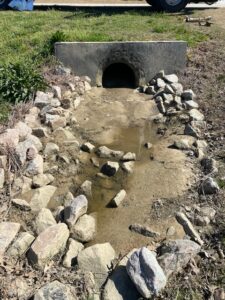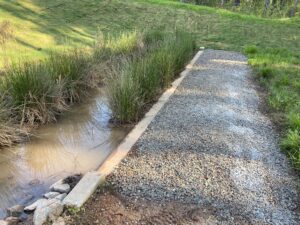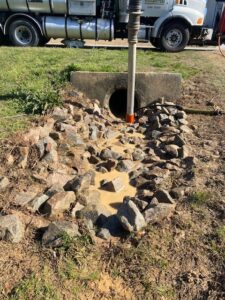Various sizes of riprap and gravel are often used in components of a stormwater management system. What role do these rocks play in managing runoff?
Riprap
Riprap is stone that is angular and usually about the size of a football. It is used to armor shorelines or areas that receive a high volume of water flow, such as below an inlet or outlet pipe or along a channel that is experiencing erosion. The riprap has two main purposes: to slow the flow of water by forcing it to navigate through the rocks and to hold sediment in place to prevent erosion.
To properly maintain riprap, displaced rock that has been washed downstream should be placed back at the dissipator. Exposed sediment fabric (often placed underneath the rock as an additional aid to hold sediment in place) needs to be covered, so riprap should be rearranged if fabric is visible. In some cases, high-volume flows of water can wash a significant portion of the riprap out of place or into the pond. Replacement or replenishment of the rock may be needed at that point. In areas with a consistent heavy flow of water, a thin layer of concrete may be poured over the riprap to hold it in place. The dissipator will still have crevices and texture, thus still slowing the water and forcing it to navigate around the rocks, but they won’t wash away.
Gravel
Gravel is used in level spreaders (specifically, #57 stone–sizes between 0.5” and 1.5”) and as a filter layer in bioretentions (at smaller sizes). It is intended to trap smaller particles of sediment than larger riprap by acting as a filter, whereas riprap functions more as an obstacle to slow water flow.
The main aspect of maintenance for gravel includes scooping the gravel out along with all the sediment that has accumulated in it, and either rinsing it clean or just replacing it with new gravel. In level spreaders, it is also important to keep vegetation from growing within the gravel to prevent debris buildup that would clog the stone even more quickly.
In both cases, water is meant to flow in between the stones, whether that is to decrease its speed (riprap) or act as a filter to trap sediment and other particles (gravel). These areas need to be repaired when the rock gets displaced or when sediment has built up in between or on top of the rocks and no longer allows water to flow through them as intended. At that point, the rock will be removed and the sediment will be scooped out. The rock will either be rinsed off and put back in place, or the dirty stone will be hauled away and new, clean stone will be put in place.
If you have questions about using riprap or gravel to improve the function of your stormwater system, please contact us today!





